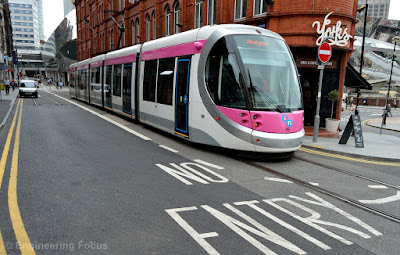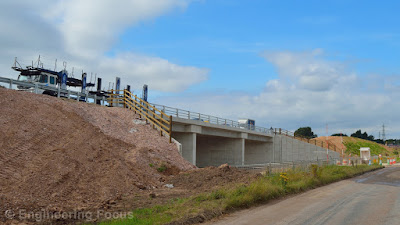The 20km Midland Metro tram line between Wolverhampton and Birmingham was officially opened on the 30th of May 1999. Plans for a network serving the West Midlands were first proposed back in 1984, however it took a further 4 years before a serious proposal was announced.
Plans for a new light rail network were announced in 1988 and in November of that year the Bill to give powers to Centro to build the first line was deposited in Parliament. The initial line would follow much of the disused track bed of the Birmingham Snow Hill to Wolverhampton Low Level Line.
The Bill became an act of parliament a year later, however construction of the £145m line (at 1995 prices) did no begin until 1995 and was expected to open in August 1998. The consortium building the new line missed the deadline by 10 months and was forced to pay compensation.
The new line which was initially constructed between Wolverhampton St George's and Birmingham Snow Hill, with 23 stops in between finally opened in May 1999. It was the intention that this first line (Line 1) would be the first of several lines which would be built connecting Wolverhampton to Walsall and Birmingham City Centre to Birmingham Airport. Unfortunately however in 1997 Centro had to concede that it was unable to find funding for it's ambitious 3 line tram network.
In 2005 The Nation Audit Office concluded that line had not reached it's full potential of 8m passengers a year, instead the number of passengers using the line reached a plateau of around 5m which was still the case in 2015. The reason given was that line did not serve Birmingham City Centre, stopping instead just outside at Snow Hill Station.
The trams
The line was served by 16 T-69 trams built by AnsaldoBreda in Italy, each tram had a capacity of 156 passengers, 100 standing and 56 seated. The trams were refurbished in 2013, yet only a year later the trams were phased out as new replacement trams arrived.
Between 2014 and 2015 the entire fleet of T-69 trams was replaced with 21 Urbos 3 trams built by CAF in Spain. These vehicles had a capacity of 210, 156 standing and 54 seated. The £40m contract for the new trams included the construction of a new maintenance facility at Wednesbury.
Urbos 3 tram passing New Street station
New Street extension
Work on the extension began in June 2012 and it was hoped the the first services would be operating by March 2015. Unfortunately a series of delays meant that by December 2015 trams were only operating as far as Bull Street tram stop. It wasn't until May 2016 that trams finally began serving New Street.
Urbos 3 tram at Birmingham New Street stop
A further boost came to Midland Metro in June 2016 when the then Secretary of State for Transport Patrick McLoughlin gave the go ahead to a £18m extension of the line in Wolverhampton. The project will extend the line along Pipers Row with stops at the bus station and the city’s railway station. The scheduled opening date for the extension is 2019.
Plans to extended the line from New Street to Centenary Square by 2019 are also at an advanced stage. Currently the line terminates at the junction of Stephenson St and Pinfold St. At this point trams turn back to make the return journey to Wolverhampton.
Stephenson St is currently the end of the line
With a new sense of optimism and with HS2 on the horizon plans are now being drawn up to build a new line branching out from Corporation Street to Curzon Street and further still to Birmingham Airport. There are also plans for an extension to Edgbaston which it is hoped will open in 2021.
It may have taken several decades but appears that the West Midlands may finally get a network worthy of it's size and importance.
Plans to extended the line from New Street to Centenary Square by 2019 are also at an advanced stage. Currently the line terminates at the junction of Stephenson St and Pinfold St. At this point trams turn back to make the return journey to Wolverhampton.
Stephenson St is currently the end of the line
Tram approaching Snow Hill stop passing No. 2 Snow Hill
Tram bound for New Street stands at Snow Hill stop
It may have taken several decades but appears that the West Midlands may finally get a network worthy of it's size and importance.




















